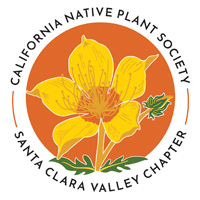On June 30th, nearly 30 CNPS members made a seven hour voyage to the area of far northern California that many consider to be the heart of the State of Jefferson. What follows is a summary of where we went and what we saw.
Situated right on the wild and scenic Klamath River, Sarah Totten campground was all ours, and offered a wonderful place for us to call Home Sweet Temporary Home. On Sunday July 1st, we caravaned to Cook & Green Pass via Saeid Creek Rd., making several stops on our way up. At our first stop, sharp eyes spotted an interesting saprophytic plant growing in the forest duff: Monotropa hypopythis or pinesap, and this was a first time sighting for most in the group. As we continued uphill, we found many other interesting and showy plants, including some that were being dug up by poachers! At the top, we explored the Pacific Crest Trail as it heads east of Cook & Green, and got a taste of the rich flora of the region and its relationship to the geology.
Monday was Calochortus day, and we traveled to three very different locations finding all three species we were seeking in nice bloom: C. persistens high up on Gunsight Ridge just west of Yreka; C. greenei just over the border into Oregon; and C. macrocarpus in a wide valley north of Mt. Shasta.
Day three saw a return to Cook & Green, this time on the PCT west of the pass towards Red Buttes. We encountered many species not seen on the other side of the pass, including a seep with Cypripedium californicum, the California lady-slipper orchid. The top of our journey to Bee Camp opened up to an area of stunning vistas and a different flora, as the local botany closely follows the local geology and microclimate.
The next day was a trip to Alex Hole, a northeast-facing cirque situated at the shoulder of Coundry Mountain. We found a stunning array of species to occur in and around this glacially-carved bowl, including choice plants from genera Lewisia, Erythonium, and Polemonium, along with several orchid species. This is also the only place we encountered melting snow. I think...
We moved camp south for the rest of the trip, to yet another paradise situated on the summit of Scott Mountain Pass, south of Etna on Hwy. 3. This campground adjacent to large meadows with seeps and fens surrounded by rich woodlands provided ample opportunity for the botanically inclined to lose themselves in the identification and appreciation of such a diversity of species.
Jefferson, we shall return.

